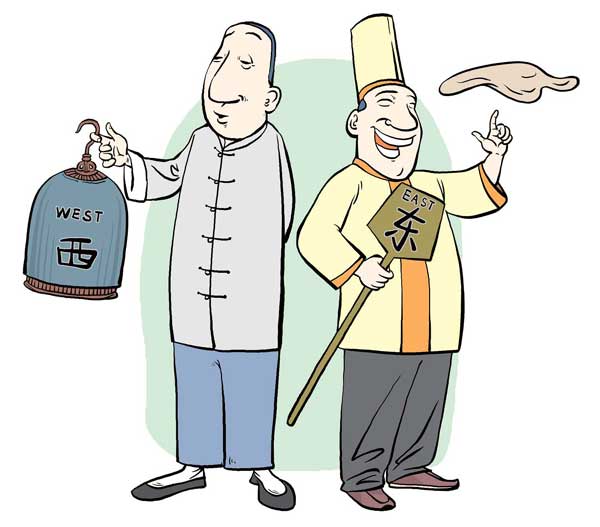Pulse
East beats west for eats, not culture
By Daniel Garst (China Daily)
Updated: 2011-04-26 07:57
 |
Large Medium Small |
 |
'I like living near Chaoyang Park way more than being west of the Second Ring Road," said a young friend and former student of mine as we sipped coffee in Sanlitun recently. "It's much livelier." His comment points to a defining feature of Beijing's east-west divide: the area east of the Second Ring Road grabs all the glory when it comes to dining and nightlife.
This split is a historical accident. Prior to the founding of New China, most foreigners lived in Beijing's old historic core, with foreign diplomatic officials housed in the legation quarter near the Forbidden City. During the 1950s, however, a new diplomatic compound was created in eastern Sanlitun. Older Chinese colleagues tell me that at that time this part of Beijing constituted its suburban fringe.
Now the area between the second and third ring roads is not just home to almost all foreign embassies but is also the city's main business district, where most major foreign businesses are headquartered in Beijing. Thanks to this combination, the eastside has the capital's biggest concentration of affluent foreigners, and that in turn has made it the premier entertainment hot spot.
Central Beijing boasts its share of restaurants, bars and nightlife, such as in Gulou, Houhai and the old legation quarter. However, the eastside, especially Sanlitun and its immediate environs, remains the location of choice for new fine dining establishments and bars. The area has also actively responded to the rising competition from its new rivals, particularly Houhai.
I can walk 30 minutes in any direction from my apartment behind Sanlitun SOHO and dine in good to outstanding restaurants serving French, Italian, German, Hungarian, Middle Eastern, Indian, Korean and Japanese cuisines. The area also abounds with good places to drink, ranging from dive bars to swank cocktail lounges and wine bars.
By contrast, outside Haidian, westside dining options consist entirely of neighborhood Chinese restaurants. One can eat well at such places, which provide very good value for money, but having a meal at them is not a special experience. And while Haidian has lots of non-Chinese restaurants and good bars, they are less upscale establishments catering to its less affluent foreign teacher and student population.
However, although west Beijing may be lacking in dining and nightlife compared to the east, it makes up for this in other areas. One is in museums.
Granted, the eastside has the China National Film Museum, but it's hard to get to, and so are most of the new art districts, save for 798 Art Zone, which has lost its avant-garde edge. West Beijing boasts the fantastic military and capital museums, which are right off Line 1 of the subway, as is the World Art Museum. It's also easy to get to the National Library and Beijing Zoo on the cleverly routed Line 4.
Haidian's universities, which include three of the best Chinese institutions of higher learning, are just up the line. East Beijing has nothing equivalent to this kind of brainpower; nor can it boast anything like the Zhongguancun high-tech cluster.
With the old and new summer palaces, the westside also beats the eastside hands down when it comes to historic places. One can add to this list the villa in Fragrant Hills where former leader Mao Zedong and his comrades planned the historic 1949 assault across the Yangtze River. In addition to the Fragrant Hills, the westside has other beautiful places for getting back to nature, including the Botanical Garden, Haidian Park, the International Sculpture Park and Yuyuantan Park, where the April cherry blossoms are a must-see. Chaoyang Park is nice, but doesn't begin to match those on the west.
So, by all means enjoy east Beijing's dining and nightlife during the evening, but during the day make an effort to experience the westside's charms.
The author is a corporate trainer for a State-owned enterprise. To comment, e-mail metrobeijing@chinadaily.com.cn. The views expressed here do not necessarily reflect those of METRO.
Comment
(China Daily 04/26/2011 page26)
| 分享按钮 |